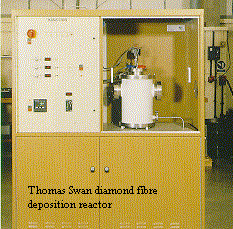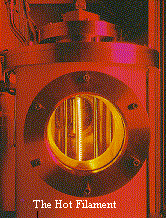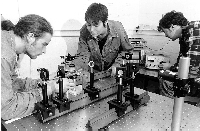 CVD Diamond Wires and Tubes
CVD Diamond Wires and Tubes
 Diamond-coated metal wires and non-metallic fibres have been fabricated (see photo right, and here for other SEM photos). Using a custom made hot filament reactor, we can simultaneously produce upto 30 diamond-coated W wires, of length 10 cm with a growth rate of about 0.5 μm/h. These wires can be used as reinforcing agents in composites, with the matrix material being a metal, such as Ti or Cu, or polymers such as plastics. Such diamond-fibre reinforced composites are significantly stiffer for their weight than any other existing material, and so have many potential applications in the Aerospace industry.
Diamond-coated metal wires and non-metallic fibres have been fabricated (see photo right, and here for other SEM photos). Using a custom made hot filament reactor, we can simultaneously produce upto 30 diamond-coated W wires, of length 10 cm with a growth rate of about 0.5 μm/h. These wires can be used as reinforcing agents in composites, with the matrix material being a metal, such as Ti or Cu, or polymers such as plastics. Such diamond-fibre reinforced composites are significantly stiffer for their weight than any other existing material, and so have many potential applications in the Aerospace industry.
Diamond Fibre Deposition Reactor
The diamond fibre deposition reactor we are currently using is a prototype machine designed and built by Thomas Swan and Co, a company specialising in vacuum equipment for the semiconductor and MOCVD industries. The machine allows us to simultaneously coat up to thirty 10-cm-long wires or fibres. The wires are usually made of tungsten, of thickness 50-200 μm, but we can also coat SiC fibres (Textron and Sigma) of thickness 100-140 μm, and bundles of smaller ceramic fibres, such as Tyranno and Nextel.
 |
 |
The Thomas Swan Reactor |
Close up of the Hot Filament Chamber |
Diamond Wire Properties
We have coated a number of commercially available metal wires and non-metallic fibres with a CVD diamond coating, making them much stiffer than before. We use tungsten as the metal core of choice, since it is cheap, available in wire form in thicknesses ranging from 10 μm to several millimetres, and is very amenable to diamond CVD. Some of the non-metallic fibres we have tried are shown in the table.
| Fibre | Composition | Diameter / μm | Diamond compatible? |
|---|---|---|---|
| Textron SCS6 | SiC on C-fibre core | 140 | Yes |
| Sigma (BP) | SiC on W wire | 100 | Yes |
| Glass Fibres (Solid or Hollow Core) | Glass or Quartz (SiO2) | 10-100 | No, shatters |
| Nicalon NL200 | Si-C-O | 14 | No, etches |
| Ti-coated Nicalon | As Nicalon, but with a 2 μm Ti coating | 14 + 2 | Yes |
| Sapphikon | Al2O3 | 100 | No, etches |
| Altex (Sumitomo) | Al2O3 85%,SiO2 15% | 12 x 17 (oval) | No, etches |
| Tyranno | Si-Ti-C-O | 8.5-11 | Yes |
| HI-Nicalon | SiC | 14 | Yes |
| Nextel | Al2O3, SiO2, B2O3 | 10 x 13 (oval) | Yes |
| Carbon fibre | C (graphite) | 20-50 | No, etches |
Examples of some of these diamond-coated fibres can be seen on the SEM photo gallery page. Typical physical properties of the diamond fibres are given below (note that exact figures depend largely upon the diamond volume fraction in the fibre). These were all measured here at Bristol, using diamond coated W wires or SiC fibres. The values are for the coated fibre, which will have contributions from the core and the diamond coating.
Measurement of Young's Modulus
 We have tested the stiffness (Young's modulus) of these fibres using a resonance interferometric method (shown right), whereby the wire is made to resonate using sound vibrations from a loudspeaker, and the movements of the wire are recorded using a laser.
We have tested the stiffness (Young's modulus) of these fibres using a resonance interferometric method (shown right), whereby the wire is made to resonate using sound vibrations from a loudspeaker, and the movements of the wire are recorded using a laser.
| Property | Fibre | Core | Diamond Coating |
|---|---|---|---|
| Young's modulus /GPa | 800-900 | 400 | 900-1000 |
| Tensile Strength /GPa | 1-2 | (small) | 1-2 |
| Strain-to-failure | 0.15% |
Bend Radius:
25 μm diamond coating on 25 μm W wire = 45 mm
25 μm diamond coating on 125 μm W wire = 141 mm
Thermal conductivity
Thermal conductivity tests show that the diamond fibres have values approximately 50% that of natural diamond. Embedded within a plastic matrix, these fibres can make efficient heat pipes.
